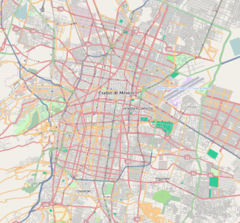
Viaducto metro station
| STC rapid transit | |||||||||||
 View of Metro Viaducto from Calzada de Tlalpan | |||||||||||
| General information | |||||||||||
| Location | Calzada de Tlalpan Mexico City Mexico | ||||||||||
| Coordinates | 19°24′03″N 99°08′13″W / 19.400808°N 99.136891°W | ||||||||||
| Line(s) | |||||||||||
| Platforms | 1 island platform | ||||||||||
| Tracks | 2 | ||||||||||
| Construction | |||||||||||
| Structure type | At grade | ||||||||||
| Platform levels | 1 | ||||||||||
| Parking | No | ||||||||||
| Bicycle facilities | No | ||||||||||
| Accessible | No | ||||||||||
| History | |||||||||||
| Opened | 1 August 1970 | ||||||||||
| Passengers | |||||||||||
| 2023 | 4,290,859[1] | ||||||||||
| Rank | 108/195[1] | ||||||||||
| Services | |||||||||||
| |||||||||||
| |||||||||||
Viaducto is a station on Line 2 of the Mexico City Metro system.[2][3] It is located in the border of Benito Juárez and Iztacalco boroughs of Mexico City, south of the city centre on Calzada de Tlalpan.[2] It is a surface station.

General information
It is represented by the stylised logo of a cloverleaf interchange, which represents crossing of Calzada de Tlalpan (a former Aztec road) and Viaducto Miguel Alemán, a crosscutting freeway that runs across the middle of the Federal District which opened in September 1950.[2][3][4] The station was opened on 1 August 1970.[5]

Ridership
| Annual passenger ridership | |||||
|---|---|---|---|---|---|
| Year | Ridership | Average daily | Rank | % change | Ref. |
| 2023 | 4,290,859 | 11,755 | 108/195 | −0.52% | [1] |
| 2022 | 4,313,392 | 11,817 | 100/195 | +31.21% | [1] |
| 2021 | 3,287,377 | 9,006 | 97/195 | −22.77% | [6] |
| 2020 | 4,256,619 | 11,630 | 84/195 | −43.58% | [7] |
| 2019 | 7,543,940 | 20,668 | 85/195 | −2.20% | [8] |
| 2018 | 7,713,645 | 21,133 | 85/195 | +1.61% | [9] |
| 2017 | 7,591,103 | 20,797 | 84/195 | −0.08% | [10] |
| 2016 | 7,597,169 | 20,757 | 87/195 | −1.48% | [11] |
| 2015 | 7,711,654 | 21,127 | 83/195 | −2.43% | [12] |
| 2014 | 7,903,530 | 21,653 | 79/195 | −8.06% | [13] |
Train crash
On October 20, 1975, at about 09:40 local time (15:40 GMT), two trains crashed, while both were going towards Tasqueña station. The first was parked at Viaducto station picking up passengers when it was hit by another train that did not stop in time. According to official reports, from 31 to 39 people died, and between 71 and 119 were injured. To date, it is the worst railroad accident recorded in the Mexico City Metro. The driver, Carlos Fernández, was found guilty and sentenced to 12 years in prison. After the crash, automatic traffic lights were incorporated to all lines.[14][15][16][17]

Exits
- East: Calzada de Tlalpan between Coruña street and Calzada Santa Anita, Colonia Viaducto Piedad
- West: Calzada de Tlalpan between Coruña street and Segovia street, Colonia Álamos
See also
- List of Mexico City metro stations
- 2020 Mexico City Metro train crash
- 2023 Mexico City Metro train crash
References
- ^ a b c d "Afluencia de estación por línea 2023" [Station traffic per line 2023] (in Spanish). Sistema Transporte Colectivo Metro. 2024. Archived from the original on 27 January 2024. Retrieved 24 January 2024.
- ^ a b c "Viaducto" (in Spanish). Archived from the original on 31 January 2012. Retrieved 14 August 2011.
- ^ a b Archambault, Richard (2011-03-07). "Viaducto » Mexico City Metro System". Retrieved 14 August 2011.
- ^ Legorreta, Jorge (16 October 2002). "Viaducto y Periférico, creaciones urbanísticas de Carlos Contreras". La Jornada (in Spanish). Retrieved 17 July 2011.
- ^ Monroy, Marco. Schwandl, Robert (ed.). "Opening Dates for Mexico City's Subway". Retrieved 14 August 2011.
- ^ "Afluencia de estación por línea 2021" [Station traffic per line 2021] (in Spanish). Sistema Transporte Colectivo Metro. 2022. Archived from the original on 7 March 2022. Retrieved 7 March 2022.
- ^ "Afluencia de estación por línea 2020" [Station traffic per line 2020] (in Spanish). Sistema Transporte Colectivo Metro. 2021. Archived from the original on 21 June 2021. Retrieved 21 June 2021.
- ^ "Afluencia de estación por línea 2019" [Station traffic per line 2019] (in Spanish). Sistema Transporte Colectivo Metro. 2020. Archived from the original on 8 April 2020. Retrieved 3 May 2020.
- ^ "Afluencia de estación por línea 2018" [Station traffic per line 2018] (in Spanish). Sistema Transporte Colectivo Metro. 2019. Archived from the original on 6 June 2019. Retrieved 7 April 2020.
- ^ "Afluencia de estación por línea 2017" [Station traffic per line 2017] (in Spanish). Sistema Transporte Colectivo Metro. 2019. Archived from the original on 3 May 2020. Retrieved 3 May 2020.
- ^ "Afluencia de estación por línea 2016" [Station traffic per line 2016] (in Spanish). Sistema Transporte Colectivo Metro. 2017. Archived from the original on 3 May 2020. Retrieved 3 May 2020.
- ^ "Afluencia de estación por línea 2015" [Station traffic per line 2015] (in Spanish). Sistema Transporte Colectivo Metro. 2016. Archived from the original on 3 May 2020. Retrieved 6 May 2020.
- ^ "Afluencia de estación por línea 2014" [Station traffic per line 2014] (in Spanish). Sistema Transporte Colectivo Metro. 2015. Archived from the original on 3 May 2020. Retrieved 6 May 2020.
- ^ Tiempo Real magazine (September 18, 2012). "El Metro de la Ciudad de México, como escenario de eventos trágicos, y muy trágicos". Sin Embargo. Retrieved July 10, 2014.
- ^ "La tragedia olvidada" (in Spanish). El Universal. Archived from the original on June 4, 2014. Retrieved July 10, 2014.
- ^ González, Juan Pablo (December 30, 2010). "Escenas impactantes en el Metro capitalino". El Universal (in Spanish). Archived from the original on March 3, 2016. Retrieved July 10, 2014.
- ^ Gutiérrez Rodríguez, Claudia Jazmín; et al. (September 28, 2013). ""CRÓNICA": El Metro del DF; 44 años de su nacimiento, 38 años de la tragedia que "nunca" existió" (in Spanish). Klika. Archived from the original on July 14, 2014.
External links
 Media related to Viaducto (station) at Wikimedia Commons
Media related to Viaducto (station) at Wikimedia Commons
See what we do next...
OR
By submitting your email or phone number, you're giving mschf permission to send you email and/or recurring marketing texts. Data rates may apply. Text stop to cancel, help for help.
Success: You're subscribed now !


